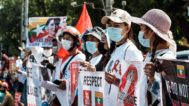Authors
Catharin Dalpino

Catharin Dalpino is professor emeritus at Georgetown University. For the past eight years she has co-chaired the monthly Southeast Asia Roundtable, sponsored by The Asia Foundation. Dalpino also served as a deputy assistant secretary for democracy at the Bureau of Democracy, Human Rights and Labor, US Department of State. She has published several books on US policy in Asia, as well as numerous articles and op-eds, and has testified frequently before Congress on US relations with Southeast Asia and is a frequent commentator for major news outlets on Southeast Asia.
Articles by Catharin Dalpino
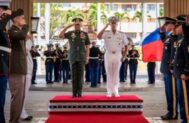
US relations with Southeast Asia ended on a down note in 2023 with the last-minute failure to finalize the trade pillar of the Indo-Pacific Economic Framework (IPEF). This was not a complete loss for ASEAN states that managed to negotiate bilateral supply chain resilience agreements. However, it underscored the fact that broad regional frameworks, particularly for trade, are off the table with Washington, at least until the United States is past the November 2024 elections. Instead, the administration focused on security over trade and on key partners in the region, with Biden skipping the East Asia Summit (EAS) in Jakarta for a visit to Vietnam and the announcement of the US-Vietnam Comprehensive Strategic Partnership. In this period, US relations with the Philippines continued to strengthen, with Washington issuing three statements calling out China for its reckless maneuvers in the Philippines’ Exclusive Economic Zone in the South China Sea. But if some Southeast Asians were miffed by the administration’s focus on bilateralism over regionalism, most were reassured by Biden’s meeting with Xi Jinping on the margins of the APEC meeting in San Francisco.
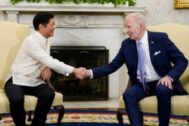
US - Southeast Asia
May — August 2023New Leaders Challenged by US-China Rivalry
Over the summer three Southeast Asian nations—Thailand, Cambodia, and Indonesia—conducted political contests or prepared for them, with Washington and Beijing watching closely for shifts in alignments or opportunities to make inroads with new leaders. Despite this, and possibly because of it, China made bold moves in the South China Sea and caused outcry in the region with the release of a map supporting its claims to the “Nine-Dash Line.” Beijing also showed signs of worry about Russian inroads into Southeast Asia and the Indo-Pacific region. The high-profile visit to Washington of Philippine President Ferdinand “Bongbong” Marcos, Jr. enabled both countries to reconfirm the US-Philippines alliance publicly, although it gave little indication of where the broader relationship may be headed. ASEAN continued to make little headway in helping to resolve the conflict in Myanmar; and the 2023 chair, Jakarta attempted to redirect the group toward economic goals and a common approach to looming food insecurity in the region.
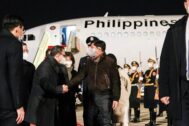
US - Southeast Asia
January — April 2023Washington Zeroes in on Manila
With an apparent renaissance in the US-Philippine alliance, spurred by rising tensions in the South China Sea and the Taiwan Strait, the Biden administration ramped up diplomatic activity with Manila as the two countries moved toward an official visit from President Ferdinand “Bongbong” Marcos, Jr., in May. At the same time, the 42nd iteration of Cobra Gold, which returned to full strength for the first time since the 2014 coup in Bangkok, suggested momentum in the US-Thailand alliance, albeit with a lower profile. While the international environment continued to be roiled by US-China rivalry, the Russian war in Ukraine, and high food and commodity prices, Southeast Asia’s own internal turmoil was evident. The junta in Myanmar extended the state of emergency and stepped up aerial bombing of areas held by the opposition and armed ethnic groups. As Indonesia takes up the ASEAN chair, prospects for implementing the Five-Point Consensus Plan are dim, if not dead. Vietnam and Thailand began leadership transitions—Hanoi with an anti-corruption purge and Bangkok with the launch of general elections—while Cambodian Prime Minister Hun Sen continued to eviscerate the opposition ahead of his near-certain re-election in July.
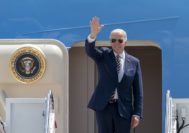
ROUNDTABLE
January 24, 2023Indo-Pacific Policy in the 2nd Half of Biden’s Term
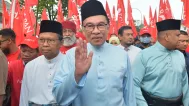
US - Southeast Asia
September — December 2022External Order, Inner Turmoil
In November three ASEAN states—Cambodia, Indonesia, and Thailand—drew favorable marks for their chairmanship of high-profile regional and global meetings: the East Asia Summit and ASEAN Leaders Meeting; the G20 Summit; and the Asia Pacific Economic Cooperation (APEC) meeting, respectively. Helming these meetings was particularly challenging for Southeast Asian leaders—who are naturally inclined to avoid strong alignments with external powers—in the current global environment of heightened tensions between the United States and China in the Taiwan Strait and the war in Ukraine. However, the year was a difficult period for ASEAN internally, with uneven economic recovery from the COVID-19 pandemic and the intractable conflict in Myanmar. The last quarter of 2022 saw two political shifts in the region: in general elections in Malaysia, Anwar Ibrahim achieved a longstanding ambition to become prime minister but will have to manage a difficult coalition to retain power. At the year’s end, Laos changed prime ministers, but it is not clear if the transition will solve the country’s debt problems, which were revealed to be more dire than estimated.

US - Southeast Asia
May — August 2022Washington Revs Up Diplomacy with Southeast Asia
The Biden administration’s diplomatic campaign in Southeast Asia kicked into high gear in the late spring and continued through the summer. On May 12-13 President Biden co-hosted, with Cambodian Prime Minister Hun Sen as the 2022 ASEAN chair, the first-ever US-ASEAN Special Summit to be held in Washington, DC. US relations in the region were also boosted when the Biden administration launched the long-awaited Indo-Pacific Economic Framework (IPEF) on May 23; seven Southeast Asian countries indicated interest in joining, although few are likely to accede to all four pillars of the framework in the near-term. Two Cabinet officials made visits to two US treaty allies: Secretary of Defense Lloyd Austin to Thailand in June and Secretary of State Anthony Blinken to the Philippines in August. Notwithstanding continuing differences over human rights, the visits served to reaffirm the bilateral alliances. However, global and regional tensions remained high, over the persistent crisis in Ukraine; brinksmanship in the Taiwan Straits; and the internal conflict in Myanmar which has only deteriorated further. These pressures only divided ASEAN further as the region looks ahead to a trifecta of international meetings—APEC, East Asia Summit, and the G20—in the fall.
Political activity was also at high levels, with elections in the Philippines; a surprise move by the Constitutional Court of Thailand to suspend Prime Minister Prayuth Chan-ocha; and a prison sentence for former Malaysian Prime Minister Najib Razak. In Thailand, Cambodia, Malaysia, Indonesia and possibly Myanmar, current political dynamics will help set the stage for elections in 2023 and 2024.
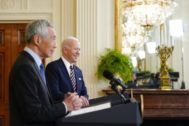
US - Southeast Asia
January — April 2022Regional Powers Cast Long Shadows: ASEAN Grapples with New Dynamics
In the early months of 2022 the Russian invasion of Ukraine had a major, if indirect, impact on Southeast Asia and its relations with the major powers. Rising commodity prices and added disruptions in global supply chains caused by the invasion threatened to erase economic gains following the damage of the COVID-19 pandemic in 2021. ASEAN splintered in its response to the invasion, putting further strain on an institution already buckling under the worsening conflict in Myanmar. A year past the coup in Naypyidaw, the ASEAN Five-Point Consensus Plan has barely moved forward. Beijing’s apparent, if cautious, support for Moscow following the invasion added new tensions in a region already on edge with growing Chinese assertiveness and a reinvigoration of US alliances. Chairing the G20 for the first time this year, Indonesia faces demands from the West to expel Russia from the group, a proposal that China vigorously opposes. The Ukraine conflict exacerbates ASEAN’s fear of being caught between the West and China, but adds a new concern that the Asia-Pacific region might further nuclearize with the threat of a nuclear standoff between Russia and NATO.
US relations with Southeast Asia began the year on a positive note following the stream of visits from high-level officials from the Biden administration in the second half of 2021. By late March, however, the US-ASEAN Special Summit had been postponed, in part because of ASEAN uneasiness over Washington’s intense focus on Ukraine. The campaign for Philippine elections was launched officially in February, and Ferdinand “Bong Bong” Marcos, son of Ferdinand and Imelda Marcos, maintained a steady lead and realized a substantial win in the presidential race on May 9, with Sara Duterte as his vice president. Politics in both Malaysia and Thailand were less straightforward, but by the end of April both countries appeared to be heading for early elections. A political transition of a different sort took place in Singapore, when President Lee Hsien-Loong named Finance Minister Edward Wong as the new leader of the People’s Action Party, effectively making Wong his political heir and the next prime minister.

US - Southeast Asia
September — December 2021Myanmar Spirals Downward While ASEAN Drifts
ASEAN unity wobbled in the final months of 2021, largely over the worsening conflict in Myanmar and the group’s inability to advance the five-point consensus plan it had forged in April. Vaccination rates for COVID-19 picked up, but governments that had hoped to return to pre-pandemic economic growth rates worried that the omicron variant would undo progress that had been made. Political challenges were no less daunting in several countries. The nomination process for May 2022 presidential elections in the Philippines showed that political dynasties are strengthening and may even merge. In Malaysia, the success of the United Malay Organization (UMNO) in state elections raised the prospect that the party will recover some of its former strength, although not its political monopoly. Anti-government demonstrations in Thailand became more perilous for protestors in November when the Constitutional Court ruled that advocating reform of the monarchy, one of the central planks of the protest movement, was tantamount to treason.
The region was also pressed to respond to great power dynamics, most notably to the announcement in September of the Australia/United Kingdom/United States (AUKUS) alliance and to China’s bid to elevate its relations with ASEAN to a comprehensive strategic partnership. At the Quadrilateral Security Dialogue Summit. the four nations opened a window to address nontraditional security threats, which could pull the ASEAN countries closer to the Quad. The Biden administration stepped up diplomacy with ASEAN with a virtual US-ASEAN Summit on the margins of the East Asia Summit in October and Secretary of State Antony Blinken’s first trip to Southeast Asia in his capacity as secretary. Although Southeast Asian leaders welcomed the attention, they are increasingly impatient for Washington to define its economic plans with the region.

US - Southeast Asia
May — August 2021Washington Finds Its Feet in Southeast Asia
In the months immediately following Joe Biden’s inauguration, Southeast Asia was on the backburner in US foreign policy, but in May the administration heeded calls for a stronger voice and more active role in the region with a succession of visits by high-level officials, culminating in Kamala Harris’s first trip to the region in her role as vice president. The cumulative impact remains to be seen, but one key “deliverable”—the renewal of the US-Philippines Visiting Forces Agreement (VFA) during Secretary of Defense Lloyd Austin’s visit to Manila—was enough to label the summer strategy a success. More broadly, the administration responded to the surge of the COVID Delta variant in Southeast Asia with donations of vaccines, making considerable strides in the “vaccine race” with China and Russia.
